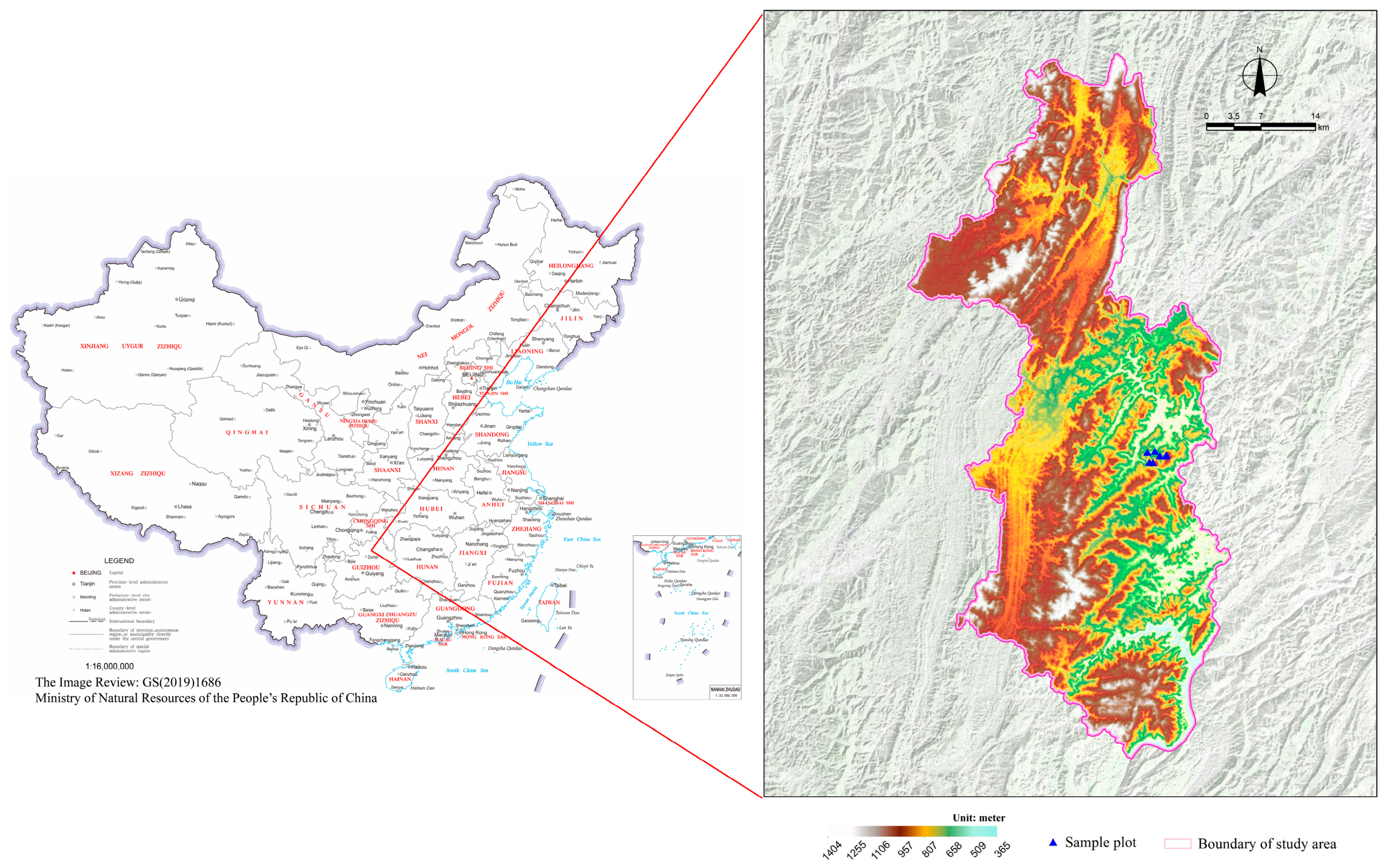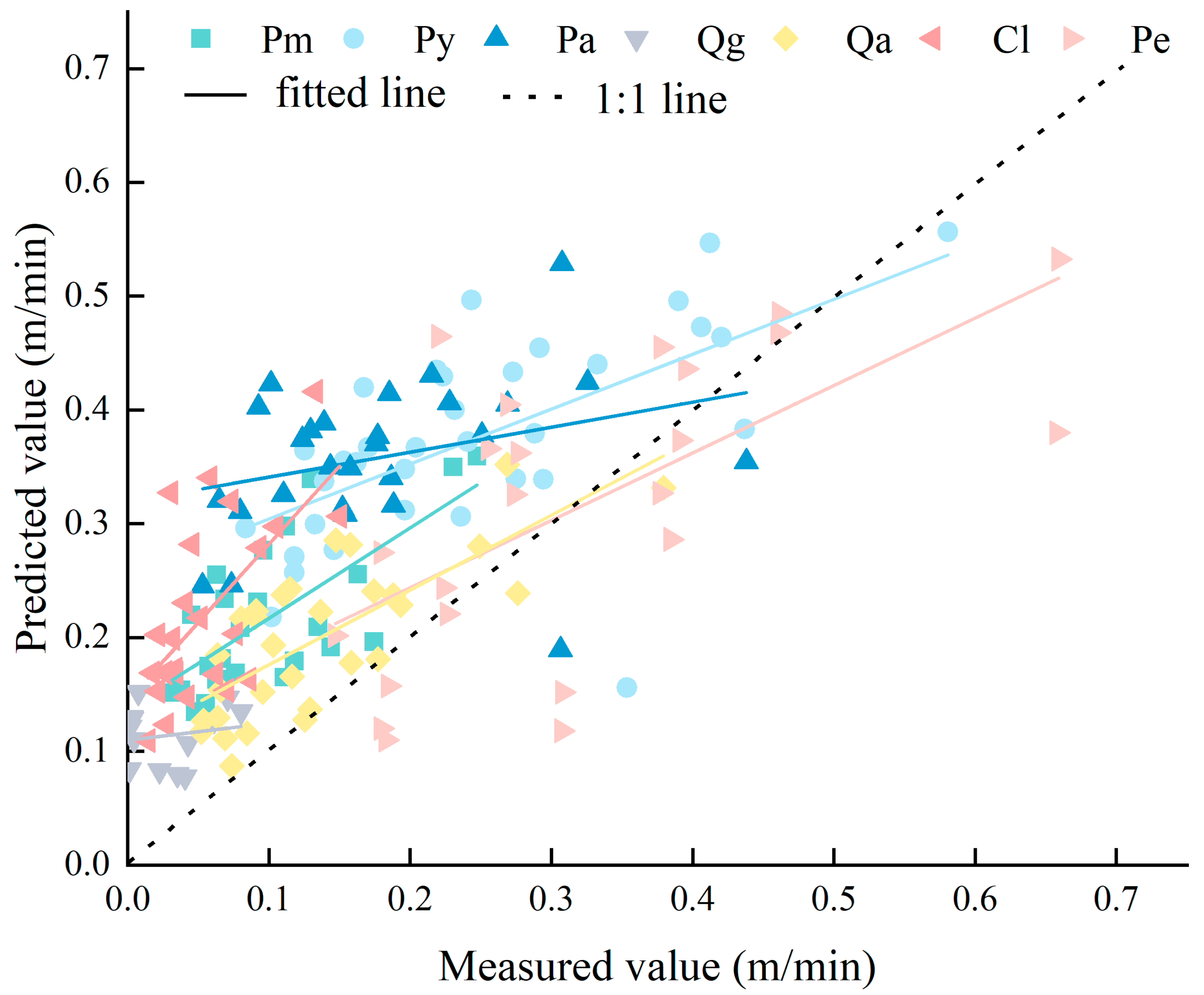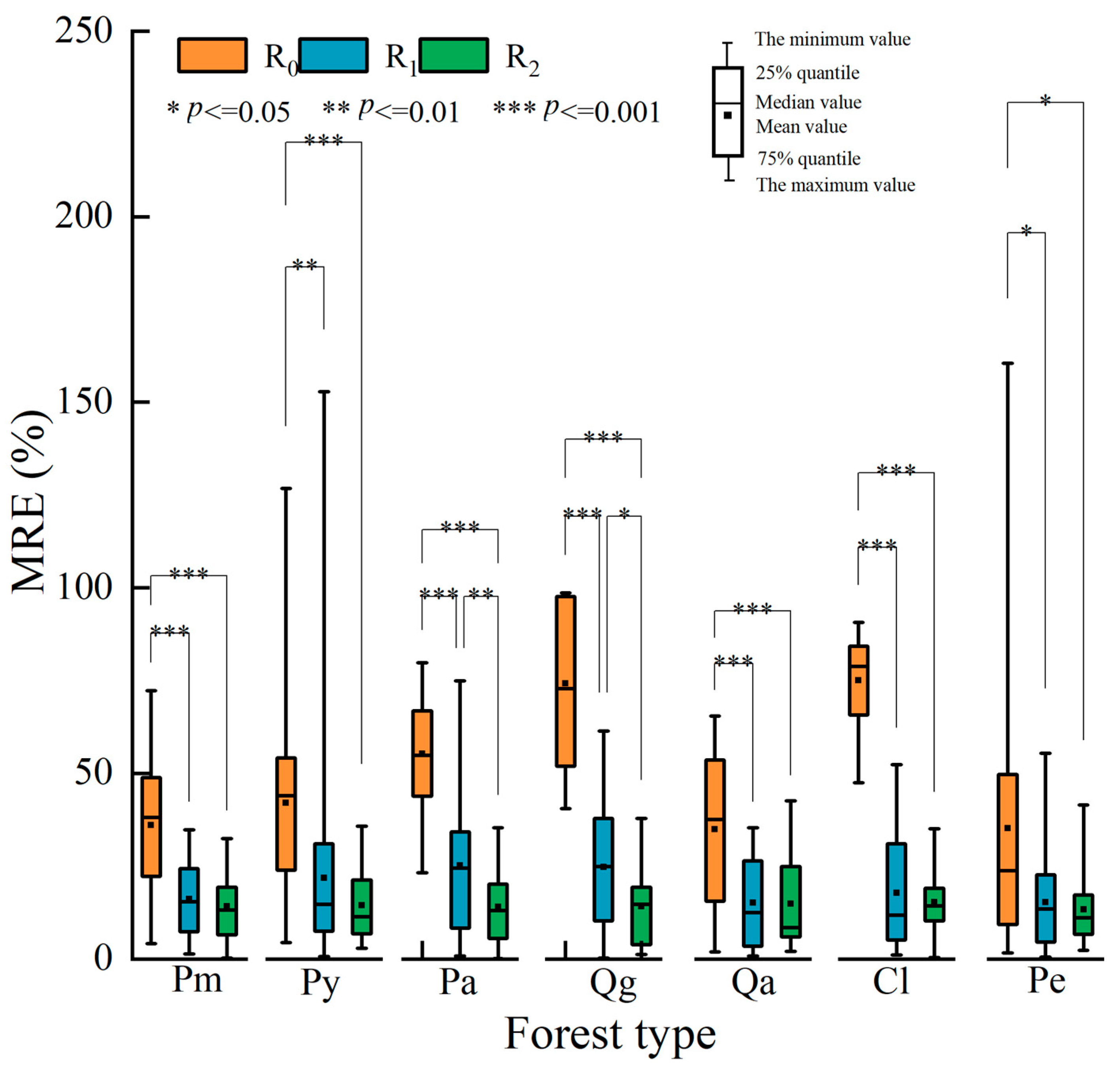Examining and Reforming the Rothermel Surface Fire Spread Model under No-Wind and Zero-Slope Conditions for the Karst Ecosystems
Abstract
1. Introduction
2. Method
2.1. Sample Collection Area
2.2. Sample Plot Setting and Fuel Characteristics Investigation
2.3. Burning Experiment
2.4. Statistical Analysis
2.4.1. Basic Information on
2.4.2. Applicability Analysis of Direct Rothermel Model
2.4.3. Rothermel Model for Re-Estimating Parameters
2.4.4. Reforming a New Prediction Model
2.4.5. Model Validation and Comparison
3. Results
3.1. Basic Information on
3.2. Applicability Analysis of Direct Use of Rothermel Model
3.3. Parameters and Errors of Prediction Model
3.4. Comparison of Model Prediction Error
3.4.1. Multiple Comparison Results of MRE of Different Models
3.4.2. Comparison between Predicted and Measured Values
4. Discussion
4.1. Basic Information on ROS0
4.2. Applicability Analysis of Rothermel Model
4.3. Analysis of Model Parameters
4.4. Prediction Effect of Model
5. Conclusions
Author Contributions
Funding
Data Availability Statement
Conflicts of Interest
References
- Rothermel, R.C. A Mathematical Model for Predicting Fire Spread in Wildland Fuels; Research Paper INT-115; USDA Forest Service, Intermountain Forest and Range Experiment Station: Ogden, UT, USA, 1972.
- Albini, F.A. Wild-land fire spread by radiation—A model including fuel cooling by natural convection. Combust. Sci. Technol. 1986, 45, 101–113. [Google Scholar] [CrossRef]
- Sullivan, A.L. Wildland surface fire spread modeling, 1990–2007. 1: Physical and quasi-physical models. Int. J. Wildland Fire 2009, 18, 349–368. [Google Scholar] [CrossRef]
- Andrews, P.L. BehavePlus fire modeling system: Past, present, and future. In Proceedings of the 7th Symposium on Fire and Forest Meteorology, Bar Harbor, ME, USA, 23–25 October 2007; Brown, T.J., Potter, B.E., Larkin, N., Anderson, K., Eds.; American Meteorological Society: Boston, MA, USA,, 2007. Available online: http://ams.confex.com/ams/pdfpapers/126669.pdf (accessed on 13 January 2023).
- Finney, M.A. FARSITE: Fire Area Simulator-Model Development and Evaluation; Research: Paper RMRS-RP-4; USDA Forest Service, Rocky Mountain Research Station: Ogden, UT, USA, 1998.
- Finney, M.A. An overview of FlamMap fire modeling capabilities. In Proceedings of the Fuels Management—How to Measure Success [Conference Proceedings], RMRS-P-41; Portland, OR, USA, 28–30 March 2006, PAndrews, L., Butler, B.W., Eds.; USDA Forest Service, Rocky Mountain Research Station: Fort Collins, CO, USA, 2006; pp. 213–220. [Google Scholar]
- Scott, J.H.; Reinhardt, E.D. Assessing Crown Fire Potential by Linking Models of Surface and Crown Fire Behavior; Research: Paper RMRS-RP-29; USDA Forest Service, Rocky Mountain Research Station: Fort Collins, CO, USA, 2001.
- Carlton, D. Fuels Management Analyst Plus Software; Version 3; Fire Program Solutions LLC: Estacada, OR, USA, 2005; Available online: http://www.fireps.Com/fmanalyst3/index.htm (accessed on 10 April 2023).
- Rossa, C.G. The effect of fuel moisture content on the spread rate of forest fires in the absence of wind or slope. Int. J. Wildland Fire 2017, 26, 24–31. [Google Scholar] [CrossRef]
- Cheney, N.P.; Gould, J.S.; Catchpole, W.R. The influence of fuel, weather and fire shape variables on fire-spread in grasslands. Int. J. Wildland Fire 1993, 3, 31–44. [Google Scholar] [CrossRef]
- Burrows, N.D. Fire behaviour in Jarrah forest fuels: 1. Laboratory Experiments. Calmscience 1999, 3, 31–56. [Google Scholar]
- Jimenez, E.; Hussaini, M.Y.; Goodrick, S. Quantifying parametric uncertainty in the rothermel model. Int. J. Wildland Fire 2008, 17, 638–649. [Google Scholar] [CrossRef]
- Finney, M.A.; Grenfell, I.C.; McHugh, C.W.; Seli, R.C.; Trethewey, D.; Stratton, R.D.; Brittain, S. A method for ensemble wildland fire simulation. Environ. Model. Assess. 2011, 16, 153–167. [Google Scholar] [CrossRef]
- Liu, Y.; Jimenez, E.; Hussaini, M.Y.; Ökten, G.; Goodrick, S. Parametric uncertainty quantification in the rothermel model with randomized Quasi-Monte Carlo methods. Int. J. Wildland Fire 2015, 24, 307–316. [Google Scholar] [CrossRef]
- Zhang, J.L.; Liu, B.F.; Di, X.Y.; Chu, T.F.; Jin, S. Fire behavior of Mongolian oak leaves fuel bed under no-wind and zero-slope conditions. analysis of the factors affecting flame length and residence time and related prediction models. Chin. J. Appl. Ecol. 2012, 23, 3149–3156. [Google Scholar]
- Cova, T.J.; Dennison, P.E.; Kim, T.H.; Moritz, M.A. Setting wildfire evacuation trigger points using fire spread modeling and GIS. Trans. GIS 2005, 9, 603–617. [Google Scholar] [CrossRef]
- Ascoli, D.; Vacchiano, G.; Motta, R.; Bovio, G. Building rothermel fire behaviour fuel models by genetic algorithm optimisation. Int. J. Wildland Fire 2015, 24, 317–328. [Google Scholar] [CrossRef]
- Sandberg, D.V.; Riccardi, C.L.; Schaaf, M.D. Reformulation of rothermel’s wild-land fire behaviour model for heterogeneous fuelbeds. Can. J. For. Res. 2007, 37, 2438–2455. [Google Scholar] [CrossRef]
- Anderson, W.R.; Cruz, M.G.; Fernandes, P.M.; McCaw, L.; Vega, J.A.; Bradstock, R.A.; Fogarty, L.; Gould, J.; McCarthy, G.; Marsden-Smedley, J.B.; et al. A generic, empirical-based model for predicting rate of fire spread in shrublands. Int. J. Wildland Fire 2015, 24, 443–460. [Google Scholar] [CrossRef]
- Yang, H.K.; Cheng, S.Z. Study on Biomass of the Karst Forest Community in Maolan, Guizhou Province. Acta Ecol. Sin. 1991, 11, 307–312. [Google Scholar]
- Hu, Z.L.; Pan, G.X.; Li, L.Q.; Du, Y.X.; Wang, X.Z. Changes in pools and heterogeneity of soil organic carbon, nitrogen and phosphorus under different vegetation types in Karst mountainous area of Central Guizhou Province, China. Acta Ecol. Sin. 2009, 29, 4187–4195. [Google Scholar]
- Sheng, M.Y.; Xiong, K.N.; Cui, G.Y.; Liu, Y. Plant diversity and soil physical-chemical properties in karst rocky desertification ecosystem of Guizhou, China. Acta Ecol. Sin. 2015, 35, 434–448. [Google Scholar]
- Zhang, Y.L.; Guo, Y.; Hu, H.Q. Characteristics of forest fire data in Southwest China during 2001–2017. J. Northwest For. Univ. 2021, 36, 179–186. [Google Scholar]
- United Nations Environment Programme. Predicting Like Wildfire: The Rising Threat of Extraordinary Landscape Fires; United Nations Environment Programme: Nairobi, Kenya, 2022. [Google Scholar]
- Niu, S.K.; He, Q.T.; Chen, F.; Wang, S.; Xu, G.X.; Sun, W. Spatial continuity of fuels in major coniferous forests in Beijing mountainous area: Fuel horizontal continuity and crown fire spread. J. Beijing For. Univ. 2012, 34, 1–9. [Google Scholar]
- Zhang, Y. Modeling the drying process of Masson pine needle fuel beds under different packing ratios based on two-phase models in the laboratory. PeerJ 2022, 10, e14484. [Google Scholar] [CrossRef]
- Garlough, E.C.; Keyes, C.R. Influences of moisture content, mineral content and bulk density on smouldering combustion of ponderosa pine duff mounds. Int. J. Wildland Fire 2011, 20, 589–596. [Google Scholar] [CrossRef]
- He, R.; Qiu, J.; Luo, B. Analysis of ash and silica content of six bamboo species. World Bamboo Ratt. 2016, 14, 1–4. [Google Scholar]
- Luke, R.H.; Mcarthur, A.G.; Brown, A.G.; Mcarthur, A.G.; Hillis, W.E. Bushfires in Australia; Australian Government Publishing Service: Canberra, Australia, 1978. [Google Scholar]
- EN 15289:2011; Solid Biofuels. Determination of Total Content of Sulfur and Chlorine. ISO: Geneva, Switzerland, 2010.
- Man, Z.Y.; Sun, L.; Hu, H.Q. Prediction model of the spread rate of eight typical surface dead fuel in Southern China under windless and flat land. Sci. Silvae Sin. 2019, 55, 197–204. [Google Scholar]
- Burgan, R.E.; Rothermel, R.C. BEHAVE: Fire Behavior Prediction and Fuel Modeling System—FUEL Subsystem; Technical Report PMS; USDA Forest Service, Intermountain Forest and Range Experiment Station: Ogden, UT, USA, 1984; Volume 439-1.
- Hu, H.Q. Forest Fire Ecology and Management; China Forestry Publishing House: Beijing, China, 2005.
- Bradshaw, L.S.; Deeming, J.E.; Burgan, R.E. The 1978 National Fire-Danger Rating System: Technical Documentation; General Technical Report INT-169; USDA Forest Service, Intermountain Forest and Range Experiment Station: Ogden, UT, USA, 1983.
- Cruz, M.G.; Alexander, M.E. Uncertainty associated with model predictions of surface and crown fire rates of spread. Environ. Model. Softw. 2013, 47, 16–28. [Google Scholar] [CrossRef]
- Sun, P.; Zhang, Y.L.; Sun, L.; Hu, H.; Guo, F.; Wang, G.; Zhang, H. Influence of fuel moisture content, packing ratio and wind velocity on the ignition probability of fuel beds composed of Mongolian oak leaves via cigarette butts. Forests 2018, 9, 507. [Google Scholar] [CrossRef]







| Tree Species | Slope (°) | Location | Range of the Fuel Height (cm) | Range of the Fuel Loading (t ha−1) | Canopy Density | Mean Height (m) | Mean DBH (cm) |
|---|---|---|---|---|---|---|---|
| Pm | 5 | Upper | 2.1–8.8 | 4.2–8.7 | 0.78 | 18.63 | 20.61 |
| Py | 9 | Downhill | 3.6–9.2 | 5.3–8.3 | 0.82 | 17.99 | 19.88 |
| Pa | 7 | Upper | 1.8–8.7 | 5.2–8.8 | 0.85 | 19.23 | 21.76 |
| Qg | 16 | Middle | 3.3–11.6 | 3.6–8.1 | 0.61 | 13.66 | 12.09 |
| Qa | 13 | Middle | 2.9–9.1 | 3.3–7.6 | 0.64 | 13.11 | 14.07 |
| Cl | 3 | Downhill | 3.6–10.9 | 4.9–9.7 | 0.72 | 10.56 | 13.23 |
| Pe | 26 | Downhill | 1.8–7.6 | 2.3–6.3 | --- | --- | --- |
| Tree Species | (cm2/cm3) Surface Area to Volume | Particle Density | Total Mineral Content | Effective Mineral Content | (kj/kg) Heat Value |
|---|---|---|---|---|---|
| Pm | 66.084 | 262.525 | 2.420 | 1.820 | 20,907.222 |
| Py | 126.638 | 245.638 | 4.000 | 3.291 | 17,598.608 |
| Pa | 94.200 | 239.203 | 3.800 | 3.127 | 21,369.512 |
| Qg | 57.783 | 311.076 | 9.690 | 8.900 | 19,659.639 |
| Qa | 90.060 | 350.911 | 6.300 | 4.151 | 19,328.418 |
| Cl | 62.257 | 201.632 | 5.160 | 4.610 | 18,667.645 |
| Pe | 148.380 | 243.502 | 10.290 | 1.840 | 19,289.666 |
| Mean | 92.520 | 264.927 | 5.952 | 3.963 | 19,545.816 |
| Tree Species | MAE (m/min) | MRE (%) | ||||
|---|---|---|---|---|---|---|
| Pm | 187.866 | 0.014 | 0.247 | 0.579 | 0.035 | 16.1 |
| Py | 74.654 | 0.006 | 0.242 | 0.462 | 0.070 | 21.6 |
| Pa | 57.686 | 0.012 | 0.203 | 0.523 | 0.093 | 24.6 |
| Qg | 83.754 | 0.018 | 0.184 | 0.519 | 0.024 | 24.8 |
| Qa | 128.474 | 0.008 | 0.233 | 0.629 | 0.034 | 16.1 |
| Cl | 192.993 | 0.014 | 0.234 | 0.565 | 0.040 | 17.9 |
| Pe | 69.673 | 0.004 | 0.215 | 0.773 | 0.050 | 15.3 |
| Tree Species | d | f | g | k | R2 | MAE (m/min) | MRE (%) |
|---|---|---|---|---|---|---|---|
| Pm | −416.79 | 0.073 | −34.713 | 12.070 | 0.723 | 0.031 | 14.1 |
| Py | −352.466 | 0.080 | −34.217 | 11.641 | 0.706 | 0.055 | 14.4 |
| Pa | −78.232 | 0.146 | −29.804 | 9.960 | 0.713 | 0.051 | 14.1 |
| Qg | −133.261 | 0.155 | −58.534 | 18.454 | 0.556 | 0.013 | 14.3 |
| Qa | −285.233 | 0.070 | −28.276 | 9.773 | 0.663 | 0.032 | 14.8 |
| Cl | −295.355 | 0.092 | −43.634 | 13.210 | 0.775 | 0.032 | 14.9 |
| Pe | −301.841 | 0.080 | −58.563 | 17.861 | 0.738 | 0.052 | 13.3 |
Disclaimer/Publisher’s Note: The statements, opinions and data contained in all publications are solely those of the individual author(s) and contributor(s) and not of MDPI and/or the editor(s). MDPI and/or the editor(s) disclaim responsibility for any injury to people or property resulting from any ideas, methods, instructions or products referred to in the content. |
© 2023 by the authors. Licensee MDPI, Basel, Switzerland. This article is an open access article distributed under the terms and conditions of the Creative Commons Attribution (CC BY) license (https://creativecommons.org/licenses/by/4.0/).
Share and Cite
Zhang, Y.; Tian, L. Examining and Reforming the Rothermel Surface Fire Spread Model under No-Wind and Zero-Slope Conditions for the Karst Ecosystems. Forests 2023, 14, 1088. https://doi.org/10.3390/f14061088
Zhang Y, Tian L. Examining and Reforming the Rothermel Surface Fire Spread Model under No-Wind and Zero-Slope Conditions for the Karst Ecosystems. Forests. 2023; 14(6):1088. https://doi.org/10.3390/f14061088
Chicago/Turabian StyleZhang, Yunlin, and Lingling Tian. 2023. "Examining and Reforming the Rothermel Surface Fire Spread Model under No-Wind and Zero-Slope Conditions for the Karst Ecosystems" Forests 14, no. 6: 1088. https://doi.org/10.3390/f14061088
APA StyleZhang, Y., & Tian, L. (2023). Examining and Reforming the Rothermel Surface Fire Spread Model under No-Wind and Zero-Slope Conditions for the Karst Ecosystems. Forests, 14(6), 1088. https://doi.org/10.3390/f14061088





